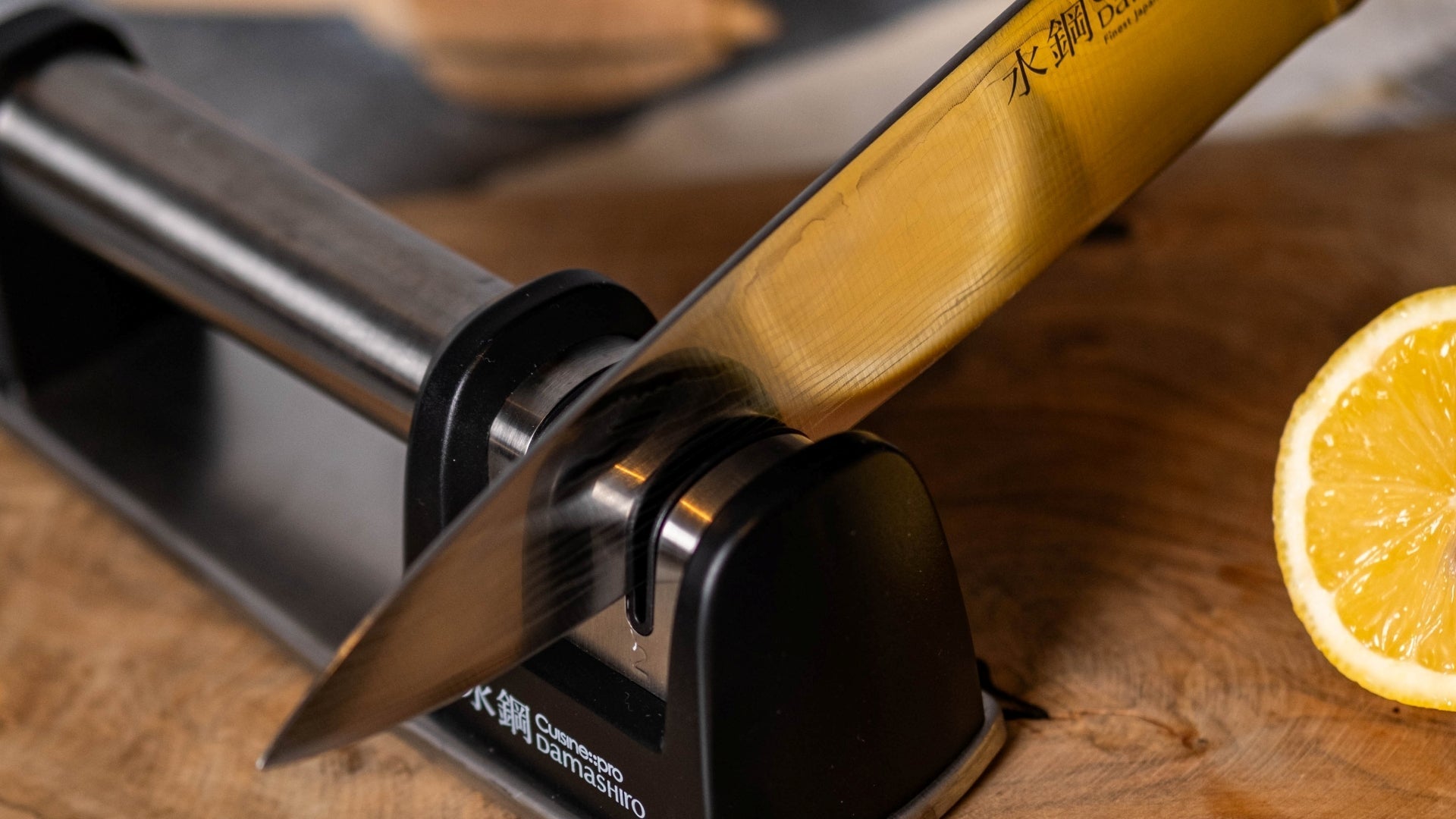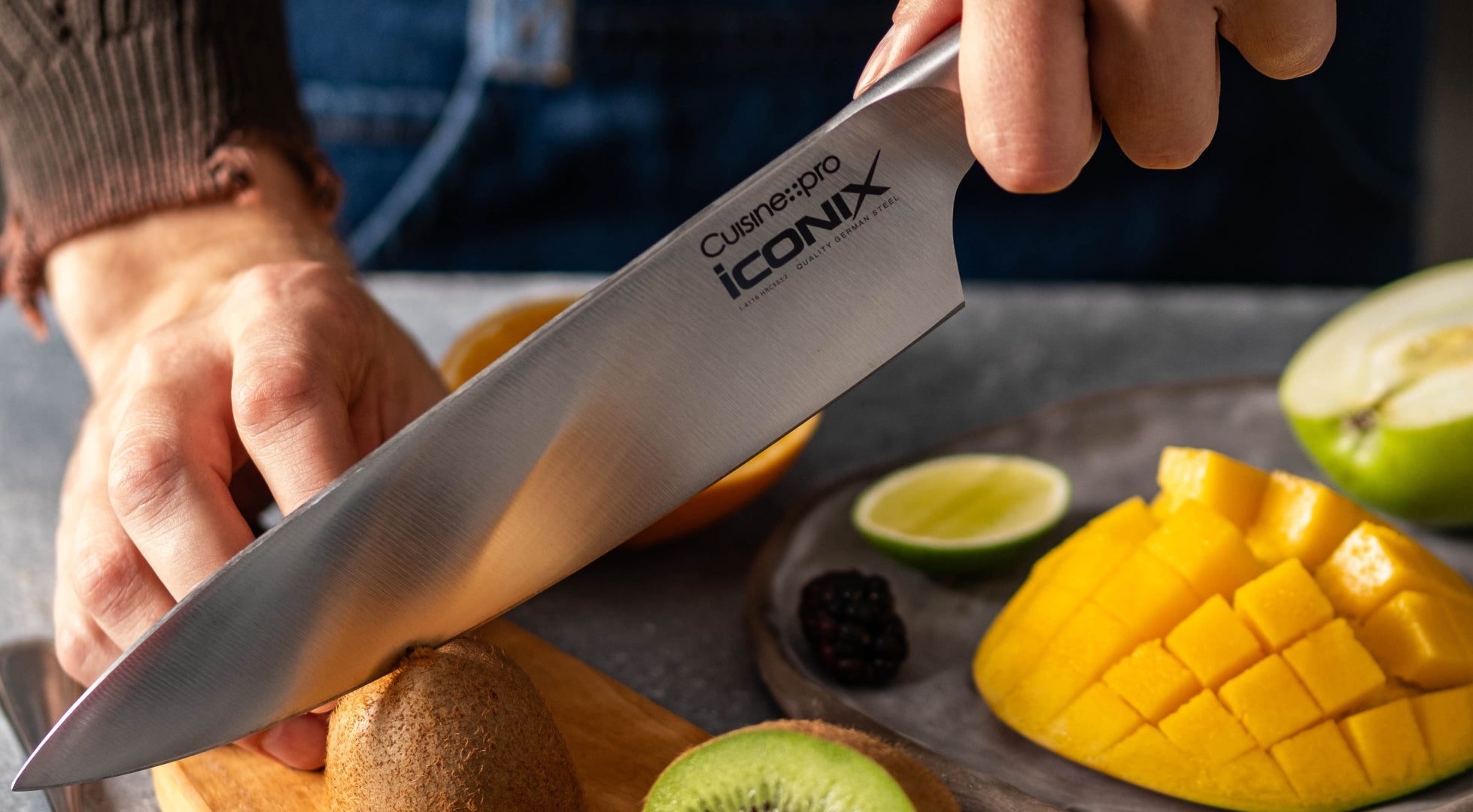The Ultimate Guide to Knife Maintenance: Tips to Make Them Last
THE CUSTOM CHEF™ . June 11, 2025

1. Introduction
There are so many reasons why you should take care of your kitchen knives. At the top of the list? As one of the must-used cutting tools in your kitchen, a sharp knife is a safe knife. It may sound counterintuitive, but sharp edges bite cleanly and easily into food. Dull edges are more likely to glance off a food’s surface—not quickly able to get through tough textures or slippery skins—and possibly slice into your hand or fingers instead.
Plus, with a little regular love, your kitchen workhorses will perform beautifully for you for years. Protect and care for blades by cleaning and storing them properly, so blades don’t rust, chip, or nick. Learn the art of sharpening and honing knives (it’s easy to do at home) so they’re ready to go when you need them.
For all the tips to keep your knives in ship sharp shape, read on!
2. The Best Way to Clean Knives
When it comes to cleaning, knives appreciate your prompt attention. Wash them immediately after using to avoid blade corrosion—a result of juices from foods (especially acidic ones like citrus, onions, or tomatoes). To clean, handwash with warm soapy water.
A few important cleaning don’ts: Don’t leave knives in the sink where they’re likely to stay damp and knock into other items, dulling and possibly chipping the blade. Don’t soak knives and don’t run them through the dishwasher. The long exposure to water and high heat in dishwashers can cause rust and corrosion to both blades and handles. Water can also seep into the joint between the handle and blade, where bacteria can build up over time. Wood handles may crack.
3. Dry Immediately
Once knives are clean, dry right away with a soft towel. If left wet, blades can begin to rust and stain.
4. Store Safely
The best way to store knives safely is in a knife block, on a magnetic strip (often mounted to a wall or cabinet), in protective sheaths, or in drawer organizers with unique compartments. All methods protect blades and keep knives separately stored from each other.
Never toss knives loose into a drawer. They’re likely to crash together when the drawer is opened and closed, causing blades to dull, nick and chip. Plus, you’re at risk of cutting yourself when you reach into the drawer.
5. Sharpening vs. Honing
It’s also important to know how to keep your knives in top form, sharpening the blades with your own whetstone, a tabletop sharpener, or through a sharpening service, such as KnifeAid. Refine the blade and maintain its edge retention by honing it.
Sharpening
Sharpening grinds a new, crisp edge onto the blade. Tools include a whetstone or a tabletop knife sharpener. You can also hand off your knives to sharpening professionals.
Whetstones require more skill and finesse than the user-friendly tabletop sharpeners, but also allow for a finer, sharper edge. This method is ideal for Japanese knives, made from softer, easy-to-sharpen steel.
To use a whetstone, first, soak your stone in water, which lets the metal blade glide across the stone’s surface, rather than catching and risking damage. Once wet, place the stone on a towel atop a cutting board with the stone’s short end parallel to the counter. Keep a small dish of water nearby so you can continue to wet the stone. Pull your knife several times across the stone—slightly angled (15 to 20 degrees toward the edge) and slowly moving from heel to tip. Make sure to do both sides of the blade, re-wetting the stone whenever necessary.
Pull-through or tabletop sharpeners, such as THE CUSTOM CHEF™ sharpening systems, conveniently combine the sharpening and honing steps into one easy-to-use device. These sharpeners have a handle on one end (with a comfortable ergonomic grip) and several slots on the other. Inside the slots is an abrasive material that sharpens and hones a blade. THE CUSTOM CHEF™ sharpeners utilize a diamond wheel to sharpen blades and a ceramic wheel to polish them. Try these tools with German steel knives, which have strong, but tougher-to-sharpen blades.
Sharpen knives every few months. You can do this at home or enlist the help of professionals. The pros use advanced tools to return knives to their sharpest, sleekest state, so blades are safer and easier to care for on your own. With services such as KnifeAid, mail in as many knives as you need sharpened (KnifeAid provides safe packaging), they’ll work their razor sharp magic, then send them back.
Honing
Honing rods don’t technically sharpen a knife, but rather realign the blade, straightening out tiny bends or dents in the metal. So just as knives need sharpening, they also need to be honed.
To use a honing rod, position the rod perpendicular to your countertop with the tip resting on a cutting board. Slowly pull the flat of your knife blade across the rod in the same manner as with the whetstone; start at the heel of the knife and pull to the tip. Do one side several times, then flip the knife over and hone the second side. Both Japanese and German steel knives will benefit from weekly honing.
Signs your knife needs sharpening
You’ll know your blade is getting dangerously dull when it:
-
Crushes tomatoes instead of neatly slicing them.
-
Slips on the surface of other foods.
-
Fails the thumb test: Gently brush your thumb across (not along) the edge of a blade. If the edge feels smooth and gives little resistance, it’s dull. If it feels sharp and tacky, it’s in good shape.
6. Long-Term Knife Care Tips
A few more guidelines to treating your knives well:
Don’t cut on glass or marble. Avoid cutting down onto a glass or stone countertop or cutting board (such as marble). Both materials will quickly dull a knife blade and are slippery and unsafe. Wood or plastic boards are best.
Use the right knife for the job. Paring knives are perfect for precise tasks and small produce. Reach for a cleaver when chopping up meat. Prepping salmon? A filleting knife is your friend. Choosing the knife designed for the job will deliver more efficient, accurate results.
Don’t use kitchen knives to pry anything apart or to cut open boxes. Prying can damage the tip of blades, while cutting through boxes and tape can dull the edges.
7. Conclusion
Taking care of your kitchen knives takes little effort but yields fulfilling results (a little like watering your houseplants). It’s all about cleaning knives promptly, storing them safely, and making regular time to hone and sharpen them. The payoff? When you properly maintain your knives, the blades will stay razor sharp and ding free, letting you rely on these essential kitchen superstars for many a meal. Head to THE CUSTOM CHEF™ to get equipped now.
Related Articles
Discover All >
